[English] 日本語
 Yorodumi
Yorodumi- PDB-8g60: mRNA decoding in human is kinetically and structurally distinct f... -
+ Open data
Open data
- Basic information
Basic information
| Entry | Database: PDB / ID: 8g60 | |||||||||
|---|---|---|---|---|---|---|---|---|---|---|
| Title | mRNA decoding in human is kinetically and structurally distinct from bacteria (CR state) | |||||||||
 Components Components |
| |||||||||
 Keywords Keywords | RIBOSOME / Human 80S / tRNA / mRNA eEF1A / eIF5A / tRNA selection | |||||||||
| Function / homology |  Function and homology information Function and homology informationcytoplasmic side of lysosomal membrane / regulation of D-erythro-sphingosine kinase activity / Eukaryotic Translation Elongation / eukaryotic translation elongation factor 1 complex / regulation of chaperone-mediated autophagy / positive regulation by host of viral genome replication / positive regulation of cysteine-type endopeptidase activity involved in execution phase of apoptosis / negative regulation of endoplasmic reticulum unfolded protein response / embryonic brain development / oxidized pyrimidine DNA binding ...cytoplasmic side of lysosomal membrane / regulation of D-erythro-sphingosine kinase activity / Eukaryotic Translation Elongation / eukaryotic translation elongation factor 1 complex / regulation of chaperone-mediated autophagy / positive regulation by host of viral genome replication / positive regulation of cysteine-type endopeptidase activity involved in execution phase of apoptosis / negative regulation of endoplasmic reticulum unfolded protein response / embryonic brain development / oxidized pyrimidine DNA binding / eukaryotic 80S initiation complex / response to TNF agonist / positive regulation of base-excision repair / negative regulation of protein neddylation / protein tyrosine kinase inhibitor activity / positive regulation of respiratory burst involved in inflammatory response / translation at presynapse / regulation of adenylate cyclase-activating G protein-coupled receptor signaling pathway / positive regulation of intrinsic apoptotic signaling pathway in response to DNA damage / positive regulation of gastrulation / axial mesoderm development / nucleolus organization / ribosomal protein import into nucleus / negative regulation of formation of translation preinitiation complex / IRE1-RACK1-PP2A complex / : / positive regulation of endodeoxyribonuclease activity / positive regulation of Golgi to plasma membrane protein transport / 90S preribosome assembly / TNFR1-mediated ceramide production / negative regulation of RNA splicing / negative regulation of DNA repair / TORC2 complex binding / negative regulation of intrinsic apoptotic signaling pathway in response to hydrogen peroxide / oxidized purine DNA binding / supercoiled DNA binding / GAIT complex / neural crest cell differentiation / NF-kappaB complex / middle ear morphogenesis / ubiquitin-like protein conjugating enzyme binding / regulation of establishment of cell polarity / negative regulation of phagocytosis / positive regulation of ubiquitin-protein transferase activity / Formation of the ternary complex, and subsequently, the 43S complex / rRNA modification in the nucleus and cytosol / erythrocyte homeostasis / cytoplasmic side of rough endoplasmic reticulum membrane / A band / laminin receptor activity / alpha-beta T cell differentiation / regulation of G1 to G0 transition / exit from mitosis / protein kinase A binding / positive regulation of intrinsic apoptotic signaling pathway in response to DNA damage by p53 class mediator / regulation of translation involved in cellular response to UV / protein-DNA complex disassembly / positive regulation of DNA damage response, signal transduction by p53 class mediator resulting in transcription of p21 class mediator / Ribosomal scanning and start codon recognition / negative regulation of ubiquitin protein ligase activity / ion channel inhibitor activity / optic nerve development / translational elongation / Translation initiation complex formation / pigmentation / positive regulation of mitochondrial depolarization / cortical actin cytoskeleton / response to aldosterone / mammalian oogenesis stage / retinal ganglion cell axon guidance / G1 to G0 transition / homeostatic process / activation-induced cell death of T cells / negative regulation of Wnt signaling pathway / lung morphogenesis / fibroblast growth factor binding / positive regulation of T cell receptor signaling pathway / positive regulation of activated T cell proliferation / iron-sulfur cluster binding / regulation of cell division / Protein hydroxylation / negative regulation of peptidyl-serine phosphorylation / BH3 domain binding / mTORC1-mediated signalling / SARS-CoV-1 modulates host translation machinery / macrophage chemotaxis / positive regulation of intrinsic apoptotic signaling pathway by p53 class mediator / Peptide chain elongation / monocyte chemotaxis / Selenocysteine synthesis / cysteine-type endopeptidase activator activity involved in apoptotic process / positive regulation of signal transduction by p53 class mediator / Formation of a pool of free 40S subunits / ubiquitin ligase inhibitor activity / Eukaryotic Translation Termination / phagocytic cup / blastocyst development / Response of EIF2AK4 (GCN2) to amino acid deficiency / SRP-dependent cotranslational protein targeting to membrane / negative regulation of respiratory burst involved in inflammatory response Similarity search - Function | |||||||||
| Biological species |  Homo sapiens (human) Homo sapiens (human) | |||||||||
| Method | ELECTRON MICROSCOPY / single particle reconstruction / cryo EM / Resolution: 2.54 Å | |||||||||
 Authors Authors | Holm, M. / Natchiar, K.S. / Rundlet, E.J. / Myasnikov, A.G. / Altman, R.B. / Blanchard, S.C. | |||||||||
| Funding support | 1items
| |||||||||
 Citation Citation |  Journal: Nature / Year: 2023 Journal: Nature / Year: 2023Title: mRNA decoding in human is kinetically and structurally distinct from bacteria. Authors: Mikael Holm / S Kundhavai Natchiar / Emily J Rundlet / Alexander G Myasnikov / Zoe L Watson / Roger B Altman / Hao-Yuan Wang / Jack Taunton / Scott C Blanchard /   Abstract: In all species, ribosomes synthesize proteins by faithfully decoding messenger RNA (mRNA) nucleotide sequences using aminoacyl-tRNA substrates. Current knowledge of the decoding mechanism derives ...In all species, ribosomes synthesize proteins by faithfully decoding messenger RNA (mRNA) nucleotide sequences using aminoacyl-tRNA substrates. Current knowledge of the decoding mechanism derives principally from studies on bacterial systems. Although key features are conserved across evolution, eukaryotes achieve higher-fidelity mRNA decoding than bacteria. In human, changes in decoding fidelity are linked to ageing and disease and represent a potential point of therapeutic intervention in both viral and cancer treatment. Here we combine single-molecule imaging and cryogenic electron microscopy methods to examine the molecular basis of human ribosome fidelity to reveal that the decoding mechanism is both kinetically and structurally distinct from that of bacteria. Although decoding is globally analogous in both species, the reaction coordinate of aminoacyl-tRNA movement is altered on the human ribosome and the process is an order of magnitude slower. These distinctions arise from eukaryote-specific structural elements in the human ribosome and in the elongation factor eukaryotic elongation factor 1A (eEF1A) that together coordinate faithful tRNA incorporation at each mRNA codon. The distinct nature and timing of conformational changes within the ribosome and eEF1A rationalize how increased decoding fidelity is achieved and potentially regulated in eukaryotic species. | |||||||||
| History |
|
- Structure visualization
Structure visualization
| Structure viewer | Molecule:  Molmil Molmil Jmol/JSmol Jmol/JSmol |
|---|
- Downloads & links
Downloads & links
- Download
Download
| PDBx/mmCIF format |  8g60.cif.gz 8g60.cif.gz | 4.9 MB | Display |  PDBx/mmCIF format PDBx/mmCIF format |
|---|---|---|---|---|
| PDB format |  pdb8g60.ent.gz pdb8g60.ent.gz | Display |  PDB format PDB format | |
| PDBx/mmJSON format |  8g60.json.gz 8g60.json.gz | Tree view |  PDBx/mmJSON format PDBx/mmJSON format | |
| Others |  Other downloads Other downloads |
-Validation report
| Summary document |  8g60_validation.pdf.gz 8g60_validation.pdf.gz | 2.5 MB | Display |  wwPDB validaton report wwPDB validaton report |
|---|---|---|---|---|
| Full document |  8g60_full_validation.pdf.gz 8g60_full_validation.pdf.gz | 2.7 MB | Display | |
| Data in XML |  8g60_validation.xml.gz 8g60_validation.xml.gz | 387 KB | Display | |
| Data in CIF |  8g60_validation.cif.gz 8g60_validation.cif.gz | 659.9 KB | Display | |
| Arichive directory |  https://data.pdbj.org/pub/pdb/validation_reports/g6/8g60 https://data.pdbj.org/pub/pdb/validation_reports/g6/8g60 ftp://data.pdbj.org/pub/pdb/validation_reports/g6/8g60 ftp://data.pdbj.org/pub/pdb/validation_reports/g6/8g60 | HTTPS FTP |
-Related structure data
| Related structure data |  29759MC 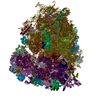 8g5yC  8g5zC 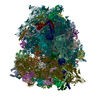 8g61C  8g6jC 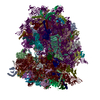 8glpC M: map data used to model this data C: citing same article ( |
|---|---|
| Similar structure data | Similarity search - Function & homology  F&H Search F&H Search |
- Links
Links
- Assembly
Assembly
| Deposited unit | 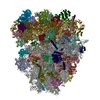
|
|---|---|
| 1 |
|
- Components
Components
-RNA chain , 7 types, 7 molecules S2L8L5L7mRAtPt
| #1: RNA chain | Mass: 603580.125 Da / Num. of mol.: 1 / Source method: isolated from a natural source / Source: (natural)  Homo sapiens (human) Homo sapiens (human) |
|---|---|
| #2: RNA chain | Mass: 50171.703 Da / Num. of mol.: 1 / Source method: isolated from a natural source / Source: (natural)  Homo sapiens (human) / References: GenBank: 555853 Homo sapiens (human) / References: GenBank: 555853 |
| #3: RNA chain | Mass: 1640884.500 Da / Num. of mol.: 1 / Source method: isolated from a natural source / Source: (natural)  Homo sapiens (human) Homo sapiens (human) |
| #4: RNA chain | Mass: 38691.914 Da / Num. of mol.: 1 / Source method: isolated from a natural source / Source: (natural)  Homo sapiens (human) / References: GenBank: 23898 Homo sapiens (human) / References: GenBank: 23898 |
| #83: RNA chain | Mass: 19128.443 Da / Num. of mol.: 1 / Source method: obtained synthetically / Source: (synth.)  Homo sapiens (human) Homo sapiens (human) |
| #84: RNA chain | Mass: 24634.879 Da / Num. of mol.: 1 / Source method: isolated from a natural source / Source: (natural)  Homo sapiens (human) Homo sapiens (human) |
| #85: RNA chain | Mass: 24848.943 Da / Num. of mol.: 1 / Source method: isolated from a natural source / Source: (natural)  Homo sapiens (human) Homo sapiens (human) |
+Protein , 78 types, 78 molecules SBSASDSJSESCSGSFSHSWSISQSUSKSOSXSMSSSdSNSLSRSPSTSVSYSZSaSbSc...
-Protein/peptide , 1 types, 1 molecules Ln
| #80: Protein/peptide | Mass: 3473.451 Da / Num. of mol.: 1 / Source method: isolated from a natural source / Source: (natural)  Homo sapiens (human) / References: UniProt: P62945 Homo sapiens (human) / References: UniProt: P62945 |
|---|
-Non-polymers , 12 types, 765 molecules 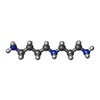
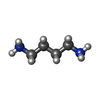


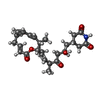


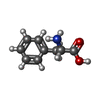
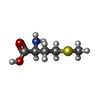
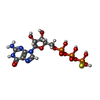
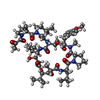












| #87: Chemical | ChemComp-SPD / #88: Chemical | ChemComp-PUT / #89: Chemical | ChemComp-MG / #90: Chemical | ChemComp-ANM / | #91: Chemical | ChemComp-3H3 / | #92: Chemical | ChemComp-K / #93: Chemical | ChemComp-ZN / #94: Chemical | ChemComp-PHE / | #95: Chemical | ChemComp-MET / | #96: Chemical | ChemComp-GSP / | #97: Chemical | ChemComp-ZIY / | #98: Water | ChemComp-HOH / | |
|---|
-Details
| Has ligand of interest | Y |
|---|
-Experimental details
-Experiment
| Experiment | Method: ELECTRON MICROSCOPY |
|---|---|
| EM experiment | Aggregation state: PARTICLE / 3D reconstruction method: single particle reconstruction |
- Sample preparation
Sample preparation
| Component | Name: Human ribosome / Type: RIBOSOME / Entity ID: #5-#26 / Source: NATURAL |
|---|---|
| Source (natural) | Organism:  Homo sapiens (human) Homo sapiens (human) |
| Buffer solution | pH: 7 |
| Specimen | Conc.: 4 mg/ml / Embedding applied: NO / Shadowing applied: NO / Staining applied: NO / Vitrification applied: YES |
| Vitrification | Instrument: FEI VITROBOT MARK IV / Cryogen name: ETHANE / Humidity: 95 % / Chamber temperature: 283 K |
- Electron microscopy imaging
Electron microscopy imaging
| Experimental equipment |  Model: Titan Krios / Image courtesy: FEI Company |
|---|---|
| Microscopy | Model: FEI TITAN KRIOS |
| Electron gun | Electron source:  FIELD EMISSION GUN / Accelerating voltage: 300 kV / Illumination mode: FLOOD BEAM FIELD EMISSION GUN / Accelerating voltage: 300 kV / Illumination mode: FLOOD BEAM |
| Electron lens | Mode: BRIGHT FIELD / Nominal defocus max: -1500 nm / Nominal defocus min: -500 nm |
| Image recording | Electron dose: 79 e/Å2 / Film or detector model: GATAN K3 (6k x 4k) |
- Processing
Processing
| EM software | Name: PHENIX / Version: 1.19_4092: / Category: model refinement | ||||||||||||||||||||||||
|---|---|---|---|---|---|---|---|---|---|---|---|---|---|---|---|---|---|---|---|---|---|---|---|---|---|
| CTF correction | Type: PHASE FLIPPING ONLY | ||||||||||||||||||||||||
| 3D reconstruction | Resolution: 2.54 Å / Resolution method: FSC 0.143 CUT-OFF / Num. of particles: 21942 / Symmetry type: POINT | ||||||||||||||||||||||||
| Atomic model building | Protocol: OTHER | ||||||||||||||||||||||||
| Refine LS restraints |
|
 Movie
Movie Controller
Controller










 PDBj
PDBj



































































